Seven natural ingredients that keep soap bacteria-free include tea tree oil (0.5-5%), lavender oil, eucalyptus oil, honey, rosemary oleoresin extract (0.1-0.5%), salt, and vinegar. Tea tree oil effectively fights Staphylococcus aureus, while honey acts as both a preservative and moisturizer. ROE prevents rancidity by inhibiting oxidation. Maintaining pH levels between 9-10 creates an inhospitable environment for microbes. These natural alternatives protect your handmade soaps without harsh chemicals while nurturing your skin.
Essential Oils With Antibacterial Properties
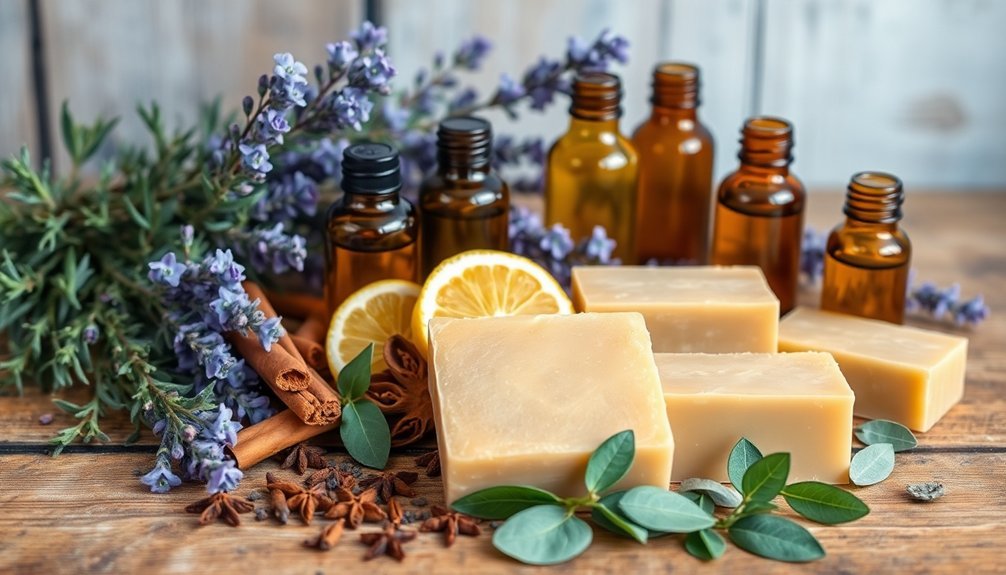
When creating natural soaps, essential oils with antibacterial properties serve as powerful ingredients that do more than just add fragrance.
You'll find tea tree oil especially effective at reducing Staphylococcus aureus on your skin, making it a cornerstone ingredient in anti-bacterial soaps.
Lavender oil offers dual benefits—its pleasant scent enhances your bathing experience while actively fighting bacteria without harsh chemicals.
Similarly, eucalyptus oil provides antimicrobial protection alongside its revitalizing aroma, ensuring your skin feels clean and invigorated.
These natural alternatives don't just clean—they nurture your skin simultaneously.
Honey as a Natural Preservative
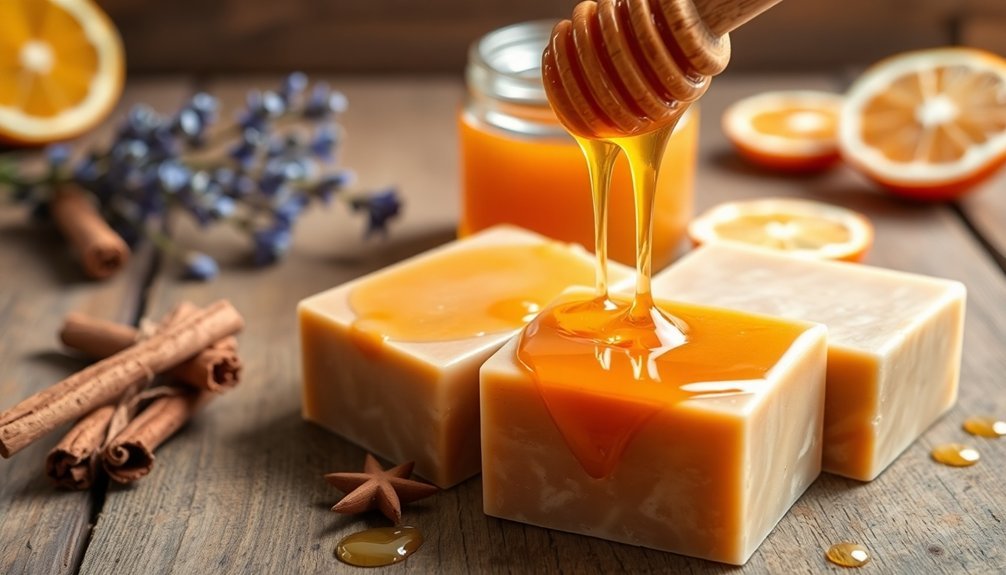
Honey's natural antibacterial properties make it an excellent preservative in your homemade soap formulations, fighting harmful bacteria while extending shelf life.
You'll benefit from honey's pH-balancing capabilities, which help maintain your skin's natural acid mantle when incorporated into cleansing products.
The moisture-retaining qualities of honey create a protective barrier on your skin, preventing water loss while delivering nutrients that keep your complexion soft and supple.
Sweet Antibacterial Properties
The natural antibacterial power of honey makes it an exceptional preservative for handcrafted soaps. When you incorporate honey into your soap recipes, you're harnessing its remarkable ability to combat pathogens like Staphylococcus aureus and E. coli through multiple mechanisms.
Honey's effectiveness stems from its unique composition—low moisture content, high acidity, and hydrogen peroxide production create an inhospitable environment for bacterial growth. It works by generating osmotic pressure that draws water from bacterial cells, effectively dehydrating and destroying them.
Beyond its antibacterial properties, honey adds stability to your soap formulations while preventing rancidity. You'll appreciate how it simultaneously fights harmful microbes and delivers moisturizing benefits to your skin.
This dual-action ingredient keeps your soap naturally preserved while enhancing its gentle cleansing qualities.
Ph-Balancing Natural Agent
Beyond its antibacterial capabilities, honey serves as a natural pH-balancing agent in your soap formulations. With an acidic pH range of 3.2 to 4.5, honey helps maintain ideal acidity levels in your bar soap, creating an environment hostile to bacterial growth.
You'll benefit from honey's dual preservation mechanism: its high sugar content creates osmotic pressure that dehydrates bacteria, while simultaneously moisturizing your skin.
This natural preservative works continuously as the enzyme glucose oxidase generates hydrogen peroxide, providing ongoing protection against microbial contamination.
When you incorporate honey into your bar soap recipes, you're not just adding a sweet ingredient – you're harnessing a complete preservation system that balances pH, fights bacteria, and extends shelf life while nourishing skin.
It's nature's preservative working effectively in your handcrafted soap.
Moisture-Retaining Skin Barrier
When incorporating honey into your soap formulations, you're creating more than just a cleansing product—you're establishing a moisture-retaining skin barrier that works continuously to protect and nourish.
Honey's natural humectant properties attract and lock in moisture, preventing your skin from drying out after washing. This moisture-retaining skin barrier is essential for maintaining healthy skin, as it helps strengthen your natural defenses against environmental stressors.
What makes honey especially valuable is its dual function: while preserving your soap by inhibiting bacterial growth through its low water activity, it's simultaneously enriching your skin with antioxidants and nutrients.
These components support cell regeneration and healing.
You'll notice your honey-infused soap not only lasts longer on your shelf but also leaves your skin feeling soothed, hydrated, and protected long after you've rinsed.
Tea Tree Oil for Long-Lasting Freshness
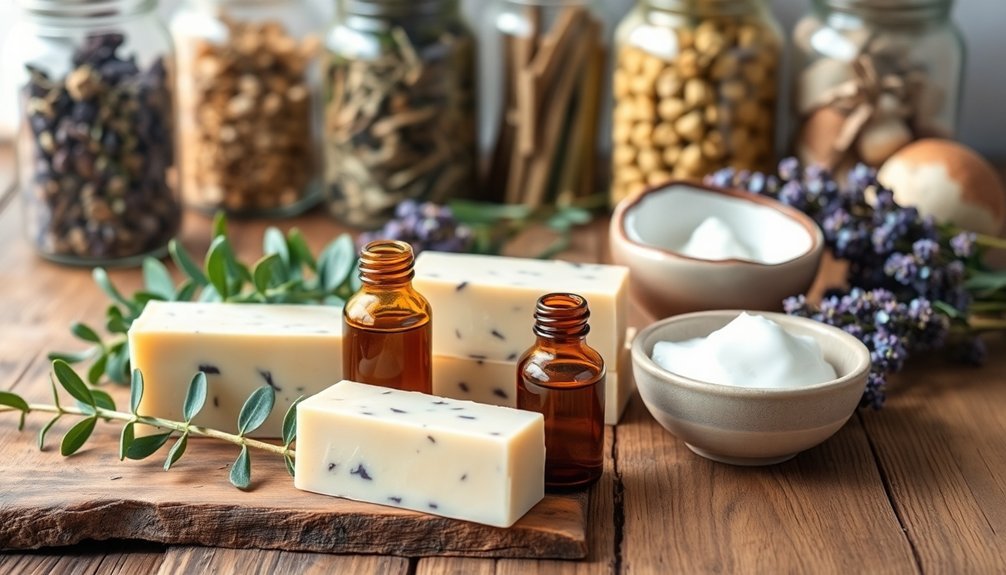
Tea tree oil stands out as a powerhouse ingredient for creating soaps that maintain freshness long after use. When you incorporate this natural extract into your personal care products, you're harnessing potent antibacterial and antifungal properties that actively combat harmful microbes like Staphylococcus aureus.
| Benefit | Application | Recommended Level |
|---|---|---|
| Antibacterial | Fights harmful bacteria | 0.5-2% |
| Antifungal | Prevents mold growth | 1-3% |
| Natural preservative | Extends shelf life | 2-4% |
| Invigorating scent | Enhances experience | 1-5% |
At just 0.5-5% concentration in your soap formulation, tea tree oil offers significant protection against microbial contamination. You'll appreciate how it keeps your soap fresh, especially in humid bathrooms, while contributing a pleasant, invigorating aroma that enhances your cleansing routine.
Grapefruit Seed Extract in Soap Making

Although less commonly discussed than essential oils, grapefruit seed extract (GSE) offers remarkable preservation benefits for homemade soaps.
Derived from grapefruit seeds and pulp, this natural preservative contains powerful compounds like flavonoids and ascorbic acid that inhibit bacterial and fungal growth in your cleaning products.
For peak effectiveness, add GSE at 0.5% to 5% of your total soap formulation. This small amount provides significant antimicrobial protection without compromising your soap's quality.
GSE appeals to consumers seeking natural alternatives to synthetic preservatives, aligning perfectly with the growing demand for clean, eco-friendly personal care items.
Remember that while GSE enhances preservation, it works best when combined with proper soap-making techniques and hygiene practices for truly safe, natural products.
Rosemary Oleoresin Extract to Prevent Rancidity
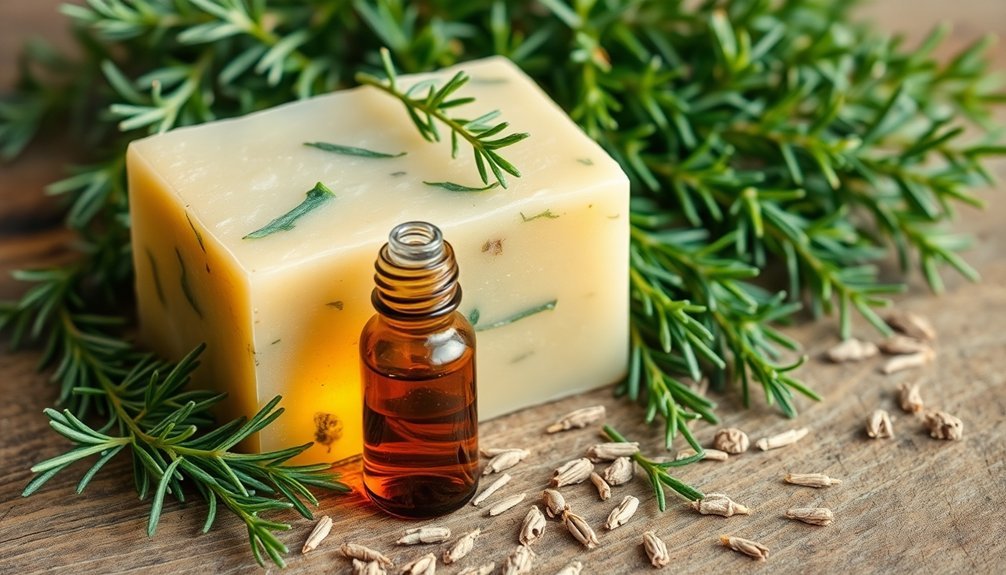
Rosemary Oleoresin Extract's powerful antioxidant compounds will shield your soap's oils from oxidation, effectively doubling or even tripling your product's shelf life.
You'll want to mix ROE at 0.1-0.5% of your total formula, thoroughly incorporating it into your oils before adding lye to guarantee even distribution throughout your batch.
Your customers will appreciate the extended freshness of scent and appearance without the addition of synthetic preservatives, making ROE an excellent choice for artisanal soapmakers committed to natural formulations.
Antioxidant Properties Explained
When crafting natural soaps, you'll inevitably face the challenge of preventing oils from going rancid. This is where Rosemary Oleoresin Extract (ROE) proves invaluable for your organic soap formulations.
ROE's antioxidant properties work by inhibiting the oxidation of unsaturated fatty acids in your oils, effectively blocking the formation of free radicals that degrade soap quality.
Unlike preservatives that target microbes, ROE specifically fights rancidity at a molecular level.
For ideal results, add ROE at 0.1% to 1% of your total formulation weight. This small addition can dramatically extend your soap's shelf life while maintaining its natural integrity.
Many soap makers appreciate that ROE complements preservatives synergistically—together they protect against both rancidity and microbial contamination while satisfying consumers' preference for natural ingredients in their skincare products.
Shelf Life Extension
Natural soaps can deteriorate quickly without proper protection, which is why Rosemary Oleoresin Extract (ROE) has become essential for artisan soap makers. This powerful natural antioxidant prevents rancidity in oils and fats, addressing health concerns associated with oxidized ingredients.
You'll find ROE particularly effective when added at 0.5% to 1% of your total oil weight. The rosmarinic acid and polyphenols in ROE work by neutralizing free radicals that cause deterioration, considerably extending your soap's shelf life without compromising scent or performance.
Unlike synthetic preservatives, ROE offers shelf life extension while maintaining your product's natural integrity. By incorporating this extract into your formulations, you're ensuring your handmade soaps remain fresh and effective over time, providing customers with stable products they can trust and enjoy longer.
Mixing ROE Effectively
For ideal results with ROE, you'll need to incorporate it properly into your soap formulations before saponification occurs. The most effective method is to thoroughly blend 0.5% to 1% of ROE (calculated against your total oil weight) directly into your oils before adding lye. This guarantees even distribution throughout your natural soap.
When measuring ROE, precision matters—too little won't provide adequate protection, while excessive amounts won't improve effectiveness. After mixing with your oils, proceed with your regular soap-making process. The ROE will work silently in the background, inhibiting oxidation while contributing its antimicrobial properties to your final product.
Remember to store your ROE in a cool, dark place between uses to maintain its potency. Proper incorporation helps maximize both shelf life and the beneficial properties of your handcrafted soaps.
Maintaining Proper Ph Levels for Microbial Control
The delicate balance of pH levels represents one of the most critical aspects of natural soap formulation. By maintaining your soap's pH between 9 and 10, you'll create an environment where most harmful microbes simply can't survive.
This natural alkalinity serves as your primary defense against bacterial growth without requiring synthetic preservatives.
You'll need to test pH consistently throughout your soap-making process to guarantee the final product offers effective antimicrobial properties while remaining gentle on skin.
If your soap's pH drifts too low, you'll create an environment where bacteria thrive; too high, and you risk skin irritation.
This careful balancing act guarantees your natural soap remains both safe and effective, providing long-lasting protection through the inherent antimicrobial qualities of properly balanced alkalinity.
Salt and Vinegar as Traditional Soap Preservatives
Pioneers of traditional soap-making discovered the remarkable preservative powers of salt and vinegar centuries before modern antimicrobial agents existed.
You'll find these pantry staples offer effective, non-toxic alternatives to synthetic preservatives in your homemade soap formulations.
- Salt inhibits harmful bacterial growth through its natural antibacterial properties.
- Vinegar's acetic acid content acts as a disinfectant against microbial contamination.
- Combining both ingredients enhances your soap's shelf life without chemicals.
- These preservatives support the clean-label movement consumers increasingly demand.
- You'll create safer products for sensitive skin by avoiding synthetic additives.
When you incorporate salt and vinegar into your soap recipes, you're tapping into time-tested preservation methods that align with today's preference for natural ingredients.
Their effectiveness in maintaining product stability means you don't need to compromise between safety and longevity.
Frequently Asked Questions
What Can I Add to Soap to Make It Antibacterial Natural?
You can add tea tree, eucalyptus, or lavender essential oils to your soap. Coconut oil, honey, aloe vera, neem oil, witch hazel, and apple cider vinegar also offer natural antibacterial properties while keeping skin moisturized.
What Is a Natural Alternative to Antibacterial Soap?
You can use plain castile soap as a natural alternative to antibacterial soap. It effectively removes bacteria through mechanical washing. Add tea tree or lavender essential oils for extra antibacterial properties while maintaining your skin's healthy microbiome.
How Do You Keep Soap From Getting Bacteria?
You'll reduce bacteria in soap by storing it in a dry, well-ventilated area. Keep soap dishes clean, guarantee proper drainage, and consider adding natural antibacterial ingredients like tea tree oil to your soap formulations.
What Makes Natural Soap Antibacterial?
Natural soap becomes antibacterial through essential oils like tea tree and lavender, glycerin that supports your skin's barrier, and its high pH level that creates an unfavorable environment for harmful bacteria to grow.
In Summary
You've now discovered seven powerful natural ingredients that'll keep your soaps fresh and bacteria-free without harsh chemicals. Whether you're choosing essential oils, honey, tea tree oil, grapefruit seed extract, rosemary oleoresin, pH balancers, or traditional salt and vinegar methods, you've got effective options for your handmade soaps. Try combining these ingredients for maximum preservation while maintaining the natural benefits your skin loves.
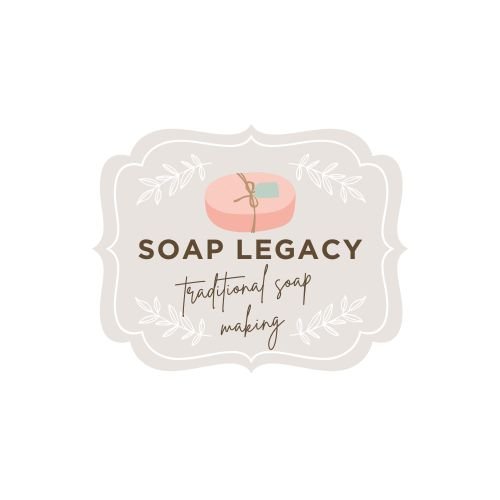




Leave a Reply